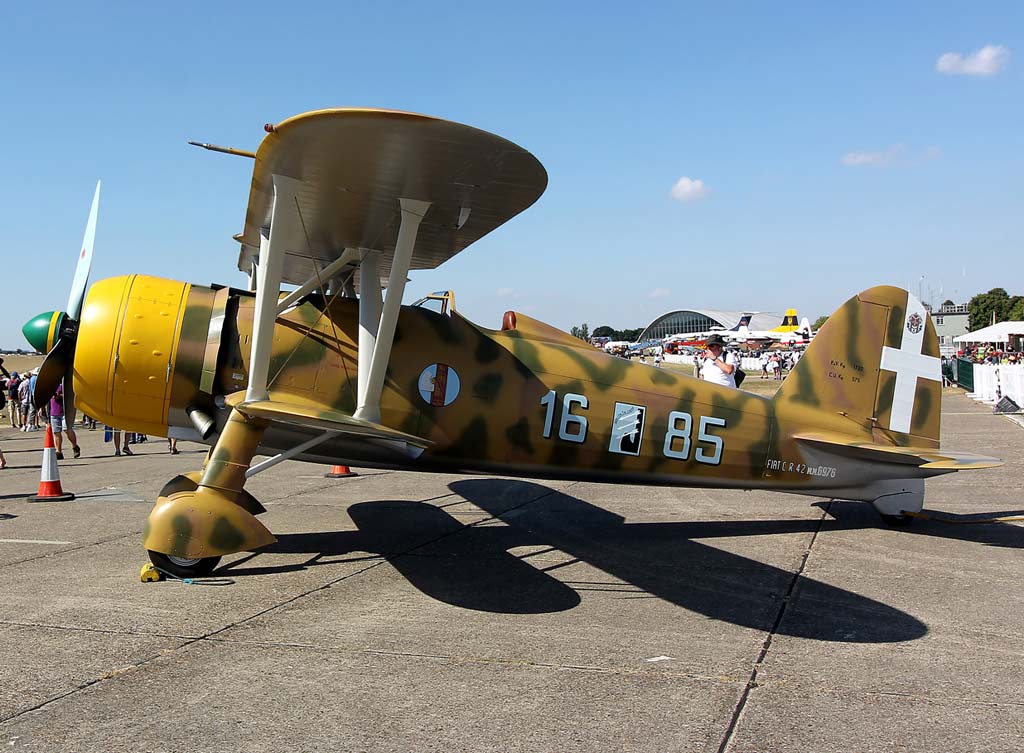The Fiat CR.42 Falco, a WWII-era Italian biplane fighter, known for its agility and speed, featuring a radial engine and open cockpit design.
This article explores the Fiat CR.42 Falco, an Italian biplane fighter of World War II. It details the historical context of its development, design features, performance characteristics, and military usage. The history section discusses the strategic needs that led to its creation, its first flight, and development goals. The design segment highlights its technical specifications and the balance between maneuverability and armament. Performance analysis compares the CR.42 with its contemporaries, emphasizing its strengths and limitations. The military use section examines its combat roles, operational history, and its eventual replacement, providing a complete overview of this iconic aircraft.
The Fiat CR.42 Falco stands as one of the last and most advanced biplane fighters developed. Used predominantly by the Italian Regia Aeronautica during World War II, it was admired for its exceptional agility and considered one of the best biplane fighters ever produced.
History of the Development of the Fiat CR.42 Falco
The Fiat CR.42 Falco was developed in a period when military aviation was transitioning from biplanes to monoplanes. Its development was driven by the Italian Regia Aeronautica’s requirement for a highly maneuverable and fast fighter. The program was initiated by Fiat’s chief designer, Celestino Rosatelli, who had a notable history of designing successful biplanes.
The CR.42 was a direct evolution of the earlier Fiat CR.32, which had garnered praise for its performance in the Spanish Civil War. The aim was to create a fighter that combined traditional biplane agility with the improved performance necessary for the upcoming conflicts.
Its first flight occurred on May 23, 1938. The CR.42 was designed during a transitional period in aviation history, where many air forces were still debating the superiority of biplanes over emerging monoplanes. As such, it was one of the last biplane fighters to be developed and represented the pinnacle of this design philosophy.
Design of the Fiat CR.42 Falco
The CR.42 Falco was a single-seat biplane fighter with an open cockpit. It had a welded steel tube fuselage with duralumin and fabric covering. The wings, also covered in fabric, featured a staggered biplane configuration, optimizing maneuverability.
It was 8.25 meters (27 feet) long, with a wingspan of 9.7 meters (31 feet 10 inches). The aircraft had an empty weight of approximately 1,782 kg (3,930 lbs) and a loaded weight of 2,295 kg (5,060 lbs). This lightweight design contributed to its agility but also limited its capacity for armor and heavy armament.
One of the unique aspects of the CR.42’s design was its combination of an advanced aerodynamic structure with the traditional biplane layout. This design provided excellent visibility for the pilot and superior maneuverability at low speeds. However, the biplane configuration limited its maximum speed and ceiling compared to contemporary monoplanes.

Performance of the Fiat CR.42 Falco
The CR.42 was powered by a Fiat A.74 R1C38 radial engine, producing 840 horsepower (626 kW). This engine enabled a maximum speed of approximately 441 km/h (274 mph) and a climb rate of 13.3 meters per second (2,620 feet per minute). The aircraft had a service ceiling of around 10,050 meters (33,000 feet) and a range of 780 kilometers (485 miles).
When compared with contemporaries like the British Hawker Hurricane or the German Messerschmitt Bf 109, the CR.42 was slower and less heavily armed. However, its maneuverability in dogfights was unmatched by most monoplanes of the era.
Military Use and Combat of the Fiat CR.42 Falco
Armed with two 12.7 mm Breda-SAFAT machine guns, the CR.42 was a formidable opponent in air-to-air combat. Its first combat missions were during the Belgian campaign and the Battle of Britain, where it faced faster and more heavily armed monoplane fighters.
The CR.42 participated in various theaters, including the North African and Eastern Fronts. Despite its agility, it was increasingly outmatched by newer monoplane designs. However, its performance in the hands of skilled pilots was still impressive.
The aircraft was exported to several countries, including Belgium, Hungary, and Sweden. As the war progressed, the CR.42 was relegated to secondary roles, such as night-fighting and training.
The Fiat CR.42 was eventually phased out of frontline service, replaced by more advanced monoplane fighters. Its last significant use was during World War II, after which it quickly disappeared from active service.
The Fiat CR.42 Falco represents the zenith of biplane fighter design, combining agility, speed, and simplicity. Although overshadowed by the advent of monoplanes, it remains a symbol of the technological and strategic transition in military aviation of its era. The CR.42’s legacy is a testament to the ingenuity of its designers and the bravery of its pilots in the face of rapid advancements in aerial warfare.
Back to the Warbirds section.